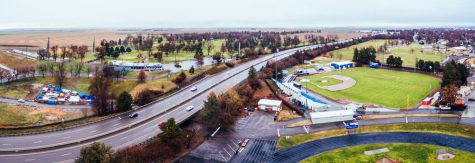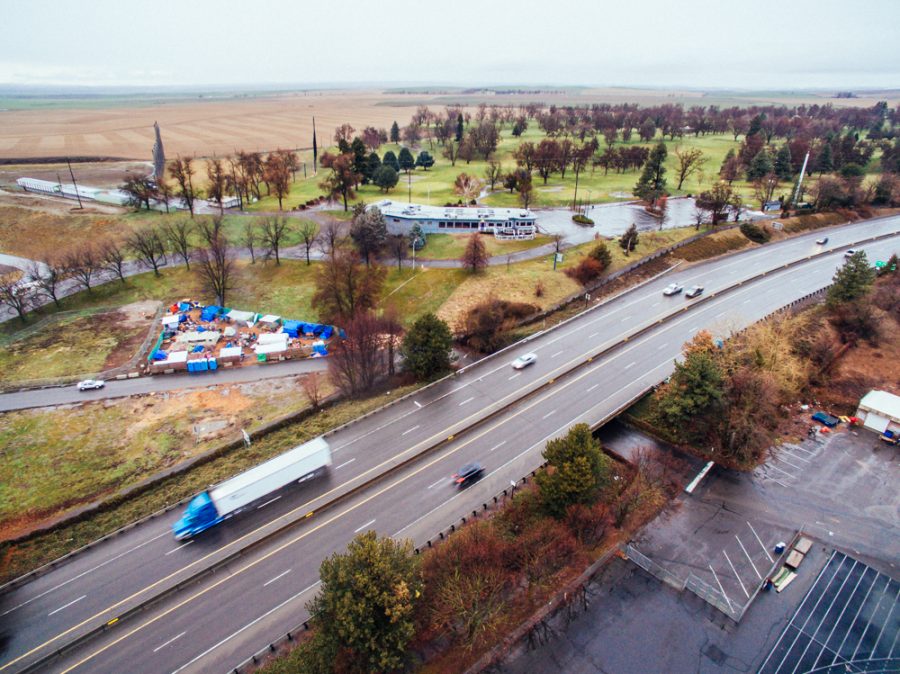Homelessness in the 509
February 23, 2017
The Walla Walla homeless encampment sits atop a small plot of land cordoned off with chain link fence, wrapped in green tarp to provide privacy. Roughly 40-50 people currently live at the Getting Off the Road Homeless Campground, sleeping in tents. The refuge was established in August of last year on city land beneath the Veteran’s Memorial Golf course. Recently, it has become the subject of much debate. The city plans to relocate the camp in April to accommodate the construction of a replacement maintenance building for the golf course after the last burnt down in an attack of vandalism.
Though there are issues with the current location, other proposed sites have been fiercely criticized for their proximity to various businesses. Currently, the City Council intends to pursue a short move across the road of about 50 feet. The city considered relocation to a portion of the Fort Walla Walla Park, but their resolve weakened as pushback grew.
“There is opposition to any site, that almost goes without saying. I think what finally made the decision for the council was the understanding from the folks at the Fort Walla Walla Museum that this is an archeological site of significance, a culturally sensitive site and that could conceivably delay things for a long time,” Councilwoman Barbara Clark said.
The site near the golf course has its disadvantages as well. Among these is the camp’s proximity to various recreational activities and businesses. City officials understand the course’s apprehension, but see no better solution.
“They don’t want it in their neighborhood for long and short-term reasons. Short term–it could chase off business. Long term–it could devalue your property,” Walla Walla Councilman Jerry Cummins explained.
Other possible locations include lots near Fifth Avenue and Sumach St and Mountain View Cemetery, respectively. Similar to the Fort Walla Walla Park, proposals promoting both sites lost momentum as concerned community members began to voice their objections. The lot near Fifth Avenue has been criticized for being too close to businesses, while the lot near the cemetery is within a block of two schools. At its root, this discontent seems more concerned with the community’s aversion to homeless people living among them than logistic difficulties.

“It all goes back to the NIMBY project, which is ‘Not In My Back Yard,’ and that is anything that is perceived to be something that people would look at as being negative, they don’t want it in their particular neighborhood,” Cummins said.
In an effort to alleviate this discomfort, the City Council has recently resolved to add a 0.1 percent sales tax to the ballot due to the correlation between insufficient affordable housing and homelessness. The tax would generate approximately one million dollars a year to be put towards affordable housing projects. It would come from the county. This was recommended by the downtown working group late last year.
“Make it the City’s top housing priority. Heed [county homeless coordinator] Sierra Knutson’s advice, ‘Given that we have less than 50 people to house in Walla Walla, it is more cost effective and humane to either find affordable housing or create more in our community,’” the group advised in a document summarizing the meeting.
In a report from the city council work session of Jan. 7, it was estimated that “costs associated with the proposed homeless policies are projected to be in the range of $150,000 annually.” The camp itself accounts for $20,000 of this, while the rest is comprised of costs associated with downtown police patrol, downtown ambassadors and Walla Walla Works (an employment program modeled after that of Albuquerque, New Mexico).
For now, the City Council is focused upon centralizing the homeless population. They recently voted five to two to go through on drafting a pair of ordinances that would ban camping on public property and sitting or sleeping on public sidewalks from 5 a.m. to 11 p.m., respectively. The general agenda is to get homeless people off the streets and into shelter, even if it is of the makeshift variety.
“I don’t want to see a maintenance program. I want to see some type of a program for people who can advance to improving their lifestyle in some way or fashion,” Cummins said.
Councilman Jerry Cummins continued, “If we can get them into some type of a safe housing environment they can start addressing the particular issues: if it’s mental illness, drug addiction, alcohol dependency, alienation from a family member or family. What can we do to get that person to begin looking at maybe taking a little bit more control of their lifestyle and identifying what they can do to improve their life.”






Samantha Parent • Feb 24, 2017 at 10:11 pm
We have a similar problem in Marin County, CA, where the “not in my backyard” sentiment reigns supreme, preventing any type of permanent housing solution from being implemented. George Lucas even offered to donate several acres of his land in the area to build permanent housing for the homeless (with services and job assistance included), but neighbors protested. Now, we have to resort to a REST (Rotating Emergency Shelter Program) hosted by local churches and synagogues who open their doors to the homeless population from Nov-Feb. A better solution is needed.
Nicole Walravens • Feb 24, 2017 at 3:30 pm
Great article! It is a good summary of what happen to homeless population in the different cities in the US. I particularly like the comment of Concilman Jerry Cummins because he talks about real solution. How amzing that increasing sale taxes by 0.1 percent could generate one million dollars a year., money that would greatly help for the building of affordable housing for homeless.
Nicole Walravens